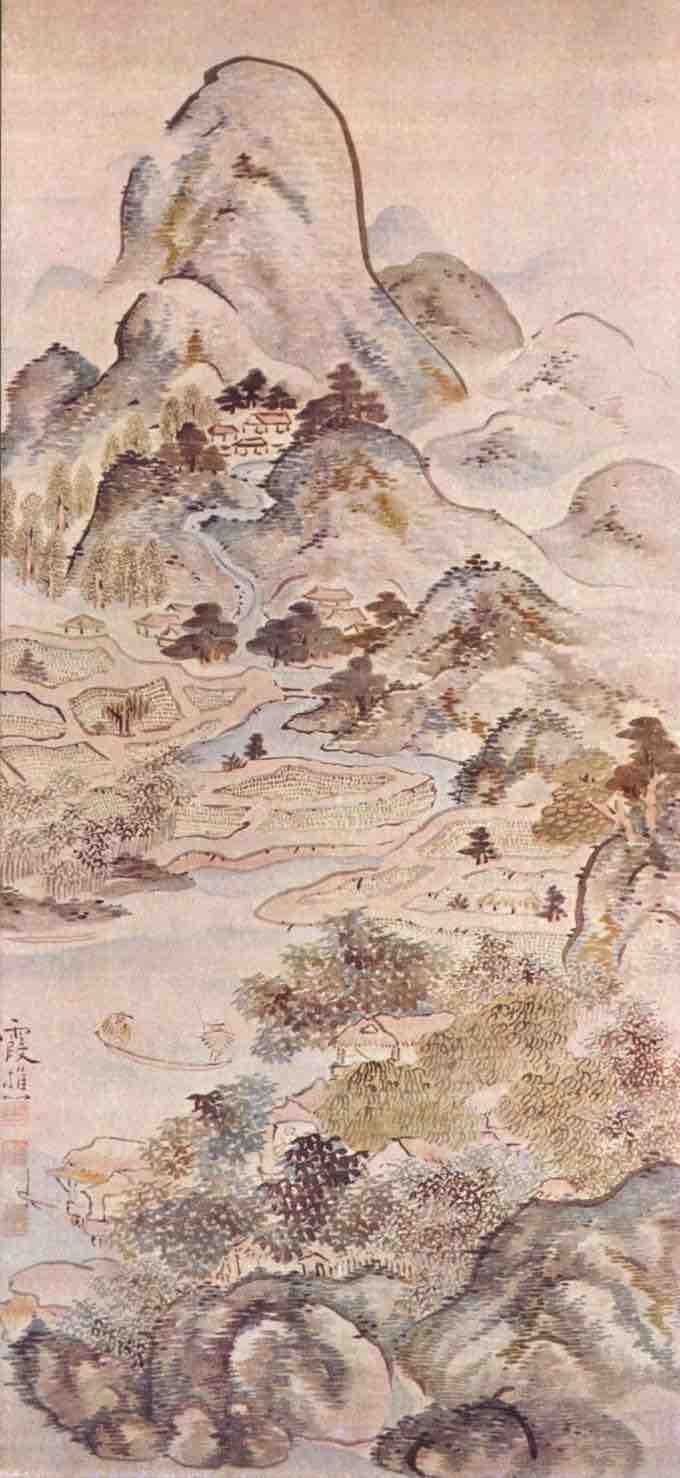Rise of Bunjinga
An important trend in the Edo period was the rise of the bunjinga genre, a kind of literati painting, also known as the Nanga school or Southern Painting school. This genre started as an imitation of Chinese scholar-amateur painters of the Yuan dynasty, whose works and techniques came to Japan in the mid-18th century. Later bunjinga artists considerably modified both the techniques and the subject matter of this genre to create a blending of Japanese and Chinese styles. Exemplars of this style include Ike no Taiga, Uragami Gyokudo, Yosa Buson, Tanomura Chikuden, Tani Buncho, and Yamamoto Baiitsu.

Fish in Spring by Ike no Taiga (1747)
Bunjinga paintings most often depicted traditional Chinese subjects. Artists focused almost exclusively on landscapes, birds, and flowers.
As part of the Nanga school, the bunjinga style of Japanese painting flourished in the late Edo period among artists who considered themselves literati, or intellectuals. While each of these artists was unique and independent, they all shared an admiration for traditional Chinese culture. Their paintings—usually in monochrome black ink, sometimes with light color, and nearly always depicting Chinese landscapes or similar subjects—were patterned after Chinese literati paintings, called wenrenhua. Poetry or other inscriptions were also an important element of these paintings and were often added by friends of the artist, rather than the artist themselves.
China's Influence
Chinese literati painting focused on expressing the rhythm of nature rather than the realistic depiction of it. However, the artist was encouraged to display a cold lack of affection for the painting, as if he, as an intellectual, was above caring deeply about his work. Ultimately, this style of painting was an outgrowth of the idea of the intellectual, or literati, as a master of all the core traditional arts—painting, calligraphy, and poetry.
Under the Edo period policy of sakoku, Japan was cut off from the outside world almost completely. Its contact with China persisted, although this was greatly limited. What little did make its way into Japan was either imported through Nagasaki or produced by the Chinese people living there. As a result, the bunjinga artists who aspired to the ideals and lifestyles of the Chinese literati were left with a rather incomplete view of Chinese literati ideas and art. Bunjinga grew, therefore, out of what did come to Japan from China, including Chinese woodblock-printed painting manuals and an assortment of paintings widely ranging in quality.
Yearning for a Pleasurable Place in Mountains of the Heart by Kameda Bôsai, 1816
Kameda Bôsai (1752–1826) was a well-known Japanese literati painter.
Bunjinga was also shaped by the great differences in culture and environment of the Japanese literati as compared to their Chinese counterparts. The form was, to a great extent, defined by its rejection of other major schools of art like the Kano and Tosa schools. In addition, the literati themselves were not members of an academic, intellectual bureaucracy, as their Chinese counterparts were. While the Chinese literati were academics aspiring to be painters, the Japanese literati were professionally trained painters aspiring to be academics and intellectuals.
Unlike other schools of art which pass on their specific style to their students, every bunjinga artist displayed unique elements in their creations, and many diverged greatly from the stylistic elements employed by their forebears. As Japan became exposed to Western culture at the end of the Edo period, some bunjinga artists began to incorporate stylistic elements of Western art into their own.
8 Daoist Immortals by Tani Bunchō
Tani Bunchō (1763 - 1841) was a Japanese literati painter and poet.